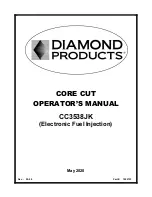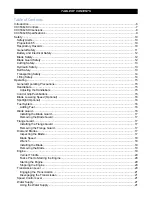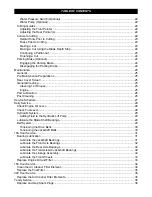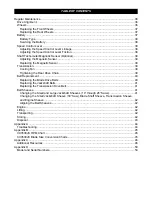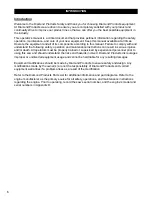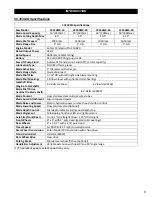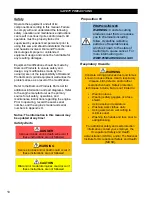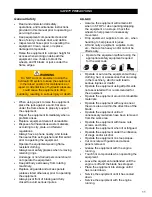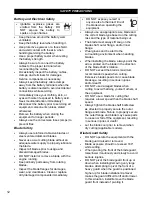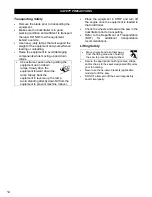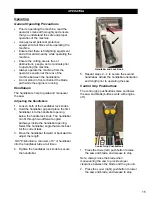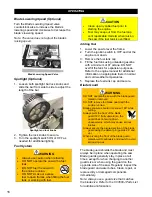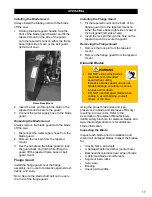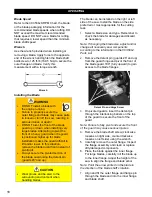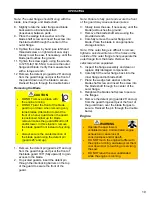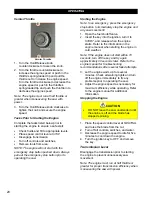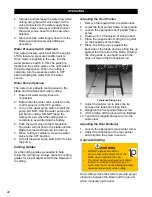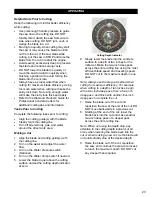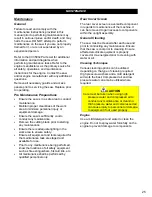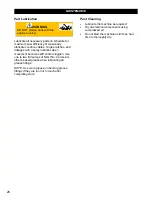
SAFETY PRECAUTIONS
•
Always pivot the front of the
blade guard 180° (fully upward)
so the guard does not swing
down unexpectedly, causing
serious injuries.
•
Always secure the pivoted section of the
blade guard using the detent pin (guards
26” and up).
•
Use extreme caution when
installing/removing parts of a guard or the
entire guard as guards can be extremely
heavy and may require installation/removal
at moderate heights.
•
DO NOT install or remove the blade guard
with the engine running.
•
Always use a blade guard that corresponds
with the blade size.
•
Inspect the blade guard and water tubes
prior to starting the equipment. Clean or
replace dirty/damaged components
immediately.
Cutting Safety
•
The direct work area should not contain
buried or embedded electrical, gas, or
water lines that could be damaged and/or
cause personal injury while cutting.
•
Turn off all electricity, gas, and water
around the direct work area prior to cutting.
•
Inspect the work area to ensure nothing will
impede full control of the machine at all
times.
•
DO NOT expose yourself or anyone else to
the direct line of the blade when operating
the equipment.
•
DO NOT allow any person, animal, and/or
objects in and around the work area while
cutting.
•
DO NOT install a blade on the machine
until it is in the cutting area.
•
Ensure the work area is adequately
illuminated to ensure safe operation of the
machine.
Hydraulic Safety
•
Turn off the engine prior to servicing
hydraulic components.
•
Lower the equipment completely prior to
servicing to decrease the hydraulic
pressure in the lines.
•
Always make sure any hydraulic
components being serviced are not
supporting the weight of other equipment
components. If a particular component is
under pressure when connection points are
loosened, oil may spray out forcefully.
•
Always place a piece of
cardboard or paper up against
hydraulic components, or use a
leak detection fluid to check for
hydraulic fluid leaks. Keep all body parts
away from leaks and/or areas that may
eject hydraulic fluid. Pressurized
hydraulic fluid can penetrate the skin,
causing serious injuries. Seek medical
attention immediately!
Belt Safety
•
Turn off the engine and let the belts cool
down prior to servicing them.
•
Regularly inspect the belts for fraying,
stress cracks, and/or breakage and replace
immediately when damaged. Always check
the belt alignment prior to operating the
equipment.
•
Use extreme caution when working with
belts and rotating machine parts to avoid
entanglement.
•
Over-tensioning belts may reduce the life of
the gearbox bearings. Under-tensioning
belts may cause slippage, shorter belt life,
and/or poor equipment performance.
•
Squealing belts indicate looseness.
•
DO NOT use old and new belts together on
the same sheave
.
13
Summary of Contents for CC3538JK Series
Page 1: ...CORE CUT OPERATOR S MANUAL CC3538JK Electronic Fuel Injection May 2020 Rev 20 00 Part 1802723...
Page 2: ......
Page 47: ...REFERENCES 47...
Page 48: ...REFERENCES 48...
Page 49: ...REFERENCES 49...
Page 51: ...REFERENCES...

